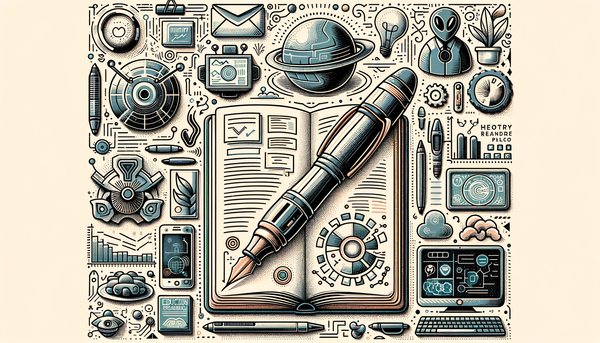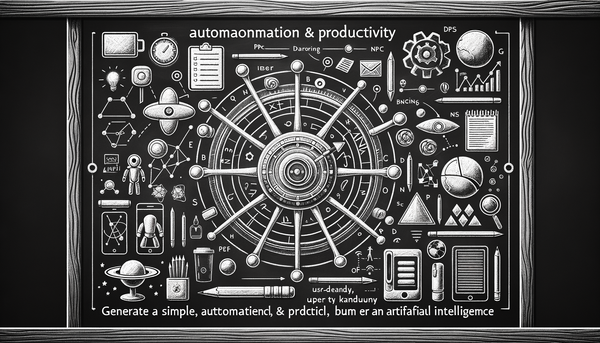AI Podcast Episode: The Transformative Journey of AI

A lively mix of unexpected visual metaphors, hard-earned lessons from AI project failures, and disruptive innovations offers a window into how artificial intelligence is reshaping not only our cultural narratives but also the very fabric of business, art, and governance.
Visual Satire and the Duality of AI Imagery
One striking example of AI's power to capture our collective imagination comes from a series of AI-generated images that have recently set social media abuzz. An image of Donald Trump wielding a red Sith lightsaber against a backdrop of American symbolism reminds us how AI can blur the lines between pop culture, politics, and satire. In the Star Wars universe, a red lightsaber is emblematic of Sith Lords and thus carries the potential to label its bearer as a villain—a nuance quickly picked up by Star Wars fans and critics alike.
This imaginative portrayal is not a one-off. A similar AI-generated depiction showed Trump in papal attire, stirring debate among conservative commentators, religious figures, and even political supporters. Comments ranged from playful jibes to serious condemnations by Catholic leaders, who argued that such images trivialize sacred iconography during sensitive times. The controversy highlights AI’s potential as both a creative tool and a provocateur—one that invites discussions about respect, authenticity, and the intersection of technology with longstanding cultural symbols.
As one observer noted, AI-generated art is a double-edged sword, capable of both reflecting and shaping public discourse. In fact, as
"visual representations become potent symbols, regardless of intent"
and as political satire merges with modern technology, it creates a canvas where humor, power, and criticism can all coexist. For further insights on how political narratives are evolving with technological innovation, you might check our AI Podcast update on innovations and trends.
Transforming Failure into Success in AI Projects
While the playful use of AI in political satire grabs headlines, the story behind many AI projects tells a story of overcoming significant hurdles before achieving success. Many practitioners have experienced what might be described as "death by isolation," overpromising, and the dangerous drift once AI systems are left unsupported after deployment.
John Defterios’ narrative on overcoming repeated AI project failures exemplifies how a change in deployment mindset can reverse fortune. His transformative fourth project involved actively engaging a product manager and integrating a user-centric feedback loop into the design. This approach re-emphasizes that the secret to a thriving AI system is less about the sophistication of the model and more about continuous adaptation, community feedback, and trust-building.
It is a reminder that behind every AI success story lies a commitment not to perfection at launch but to relentless improvement. This user-centric approach is fundamental, for instance, in healthcare and compliance scenarios, where a well-oiled feedback loop led to improved outcomes such as a 21% reduction in compliance errors and over 80% positive user satisfaction. Such insights also point to the need for treating AI as a living entity—constantly updated and refined rather than a one-off technological novelty.
Through embracing failures as opportunities to learn, the AI landscape is steadily evolving. This evolution echoes the sentiment that “AI is a tool. The choice about how it gets deployed is ours,” as quoted by Oren Etzioni. For more tales of AI evolution and lessons learned along the way, explore our AI Innovations and Challenges section.
Art, Copyright, and the Creative Renaissance Powered by AI
The incorporation of AI in the creative arts is a lively domain of both innovation and controversy. With over 1,000 AI-enhanced works now protected under US Copyright Law, the focus has shifted from questioning the role of AI in creativity to understanding when AI acts merely as an auxiliary tool versus becoming the primary creator. The US Copyright Office’s landmark decision underscores a poignant cultural shift: while AI can intensify creative output, it must ultimately serve to amplify the human spirit of innovation.
Consider the case of a country singer who used an AI-generated clone of his voice in a new album. This blend of technology and artistry not only highlights the ease of access to advanced creative tools but also exposes the tension between originality and automation. Even renowned musicians like Paul McCartney have expressed concerns that such technologies could jeopardize future creative prospects if they are allowed to overshadow human talent.
This evolution in the legal landscape highlights the need for nuanced regulations that both encourage innovation and protect the livelihoods of creators. With legal battles in the background and vibrant debates on the horizon, the creative industry is at the cusp of a renaissance—a dialogue where technology continuously informs and transforms art.
In an era where music, films, and images are rapidly produced with the help of technology, these legal and ethical challenges are bound to intensify. It’s a vivid example of how AI can both empower and complicate established structures. Those interested in understanding how AI shapes not just business or policy but also art should delve into related updates on our site.
Workplace Revolution and the Socio-Economic Impact of AI
Behind the curtain of artistic expression and political satire lies a critical layer of economic disruption. As AI continues to proliferate in workplaces, experts warn of its two-faced potential: on one side, promising unprecedented efficiency; on the other, risking the exacerbation of existing inequalities. This balancing act between cutting-edge technology and socio-economic fairness is a recurring theme in discussions about the future of work.
Research by the UN Trade and Development agency indicates that nearly 40% of global jobs could face displacement due to automation. Leaders across industries are thus tasked with a dual responsibility: harnessing AI to streamline operations while retraining existing workforces for new roles that technology cannot easily replicate. Tomasz Kurczyk's analogy of an impending tsunami aptly captures the dual energy of these technological tides—both invigorating and potentially destructive.
Innovative companies are responding by reimagining their work structures. They are proactively upskilling their employees, creating new roles that dovetail with AI’s strengths, and ensuring transparency and accountability in the deployment of digital labor. While 82% of business leaders show confidence in their ability to adopt AI tools in the near future, a crucial element remains: the need for human-centric adaptation strategies that prioritize ethical practices and bridge the widening skill gap.
This conversation is more than about job statistics or economic forecasts. It is also deeply human. As AI enters every facet of our work environments, institutions must collaborate to create frameworks that nurture both innovation and inclusivity. For those keen on understanding these trends further, our detailed analysis in the Today’s AI Innovations & Challenges post offers a broader picture of the evolving digital workforce.
Government, Coding, and the Integration of AI for Public Good
Artificial intelligence is not confined to private enterprises and creative industries; it is also making significant inroads into government and public services. At the recent Milken Institute conference, Elon Musk posited that AI could help alleviate the impact of workforce reductions in the public sector by automating routine tasks. Although this view attracted both support and caution, it underscored a critical truth: AI’s potential to increase efficiency extends across all facets of society.
Automating mundane tasks presents a compelling case for public sector transformation—from streamlining administrative processes to enhancing service delivery to citizens. However, there is a delicate balance to be maintained. While AI has the potential to offset job losses, critics caution that not every role will be suited for automation, especially those requiring human empathy, critical thinking, and nuanced decision-making.
Beyond the corridors of government, innovators in the tech start-up space are marrying the worlds of coding and creativity. Cursor, a maker of the so-called "vibe coding" app, has achieved a striking $9 billion valuation by tapping into both the technical and emotional dimensions of software development. This fusion of data-driven insights and the emotional sensibilities of developers is laying the groundwork for a new era in digital innovation—a transformation that blurs the boundaries between logic and artistry.
Both in the public and private sectors, the drive for efficiency is clear. The challenge is to integrate AI in ways that prioritize human values, foster creativity, and ensure that technological progress is equitable and sustainable. It is an evolving dialogue where every decision shapes the blueprint of our collective future.
Reflections on Authenticity, Learning, and the Impact of AI on Identity
No discussion on artificial intelligence would be complete without acknowledging its influence on personal development and educational paradigms. In a reflective piece aimed at younger generations navigating the waves of technological change, a veteran academic mused on how AI, despite its vast potential, cannot substitute for the passionate exploration of human creativity and personal identity.
This perspective resonates deeply in an era of machine-assisted learning. The concern remains that while AI can provide rapid and seemingly comprehensive research tools, it may also encourage a homogenization of thought—akin to consuming nutritious yet unimaginative instant mashed potatoes. The call is clear: technology should be used to complement, not replace, the vibrant process of learning, self-discovery, and intellectual expression.
Furthermore, the reflections on identity and change serve as a reminder that whether you are a student just beginning your journey or a seasoned professional adapting to change, the core human desires for connection and purpose remain unchanged. Embracing these changes means navigating both the perils and promises of AI while holding onto what makes us intrinsically human.
This message is particularly poignant in today’s increasingly digital environment—a time when change is the only constant, and authentic learning arises from a fusion of human passion and technological support. As Helen Hudson aptly put it in her reflective musings, the journey towards personal growth and fulfillment requires a balance between the tools we wield and the passions that drive us forward.
Looking Ahead: The Roadmap to an AI-Integrated Future
The transformative journey of AI is an unfolding narrative—a tale that interlaces creativity, political satire, workplace evolution, and governmental reform. At its heart, the narrative is not just one of technology, but of humanity striving to harness digital tools in ways that enrich our collective experience. Whether we are discussing controversial imagery that challenges cultural symbols, iterating on AI projects through resilience and feedback, or ensuring that the integration of digital labor supports both efficiency and ethical responsibility, the future of AI remains a complex yet exciting frontier.
Exploring this multifaceted landscape reminds us that every breakthrough comes with a set of challenges, and every failure holds the seeds of future success. As we navigate this journey, there is wisdom in remembering that technological progress should be accompanied by ethical vigilance and a continued commitment to human values. The integration of AI into our educational, artistic, and professional lives signifies a new chapter in our cultural evolution—one that is rich with possibility but also demands careful stewardship.
In reflection, as echoed by tech innovators and cultural commentators alike, "Artificial intelligence is the science of making machines do things that would require intelligence if done by men." This statement carries a timeless quality that encapsulates both the promise and the caution entwined in every technological revolution.
For enthusiasts eager to dive deeper into the nuances of AI's evolving role, our ongoing series of podcast updates and detailed analyses on the AI.Biz website continue to serve as invaluable resources—a testament to the rich dialogue between technology, policy, and culture.
Final Thoughts
In a world where every breakthrough sparks both debate and admiration, the transformative journey of AI reminds us that every innovation is interwoven with the fabric of our social and cultural history. With each new image, project, or policy, we are offered a glimpse into a future where technology and humanity walk hand in hand—challenging, inspiring, and ultimately defining the spirit of our times.



